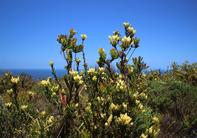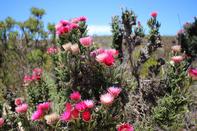Fynbos and Cape Floral Region
Technically, the term ‘Fynbos’ only refers to fine-leaved plants, like the various Erica and Heather species. Unofficially, however, the name has come to include the entire Cape Floral Region, which includes Proteas, Rhus trees and Dune Milkwoods. Collectively, these plants form the smallest and most biologically diverse of the world’s seven floral kingdoms.

Fynbos in the Overberg region has earned this distinction because it contains over 8 500 species of plants, all living in a tiny area of 90 000 km2. 70% of these species are found nowhere else on Earth. In fact, the Cape Peninsula alone contains more plant species than the British Isles, and the Cape Floral Region as a whole is as biologically diverse as the entire continent of Europe.
UNESCO World Heritage Site

The endless adaptation of the Fynbos is a result of its determination to survive in a difficult micro-climate. Strong winds, winter rainfall and nutritionally poor soil of the South-Western Cape have all combined to create an unlikely home for this hardy family of plants, which grows like a blanket from the foothills to the sea.
The Fynbos has even adapted to the regular fires that sweep through the region every few years, and the heat of a passing fire is often required to release the seeds that will spawn a new generation.
Unfortunately, Fynbos is very susceptible to foreign vegetation and can easily be pushed out by more assertive species. Rampant housing developments, pollution and wanton destruction of the Fynbos has also taken its toll. Luckily, Fynbos is now heavily protected, and you can be fined for illegal picking and poaching of the plants.
The Cape Floral Region is now a UNESCO World Heritage Site, and is sheltered in a series of eight protected areas around the Western Cape: Table Mountain, Groot Winterhoek, Cederberg, Boland Mountain Complex, De Hoop, Boosmansbos, Swartberg and Baviaanskloof.
 The Fynbos Route is situated in the Overberg region of the Western Cape province of South Africa. This route takes you into the hidden corne...
The Fynbos Route is situated in the Overberg region of the Western Cape province of South Africa. This route takes you into the hidden corne...